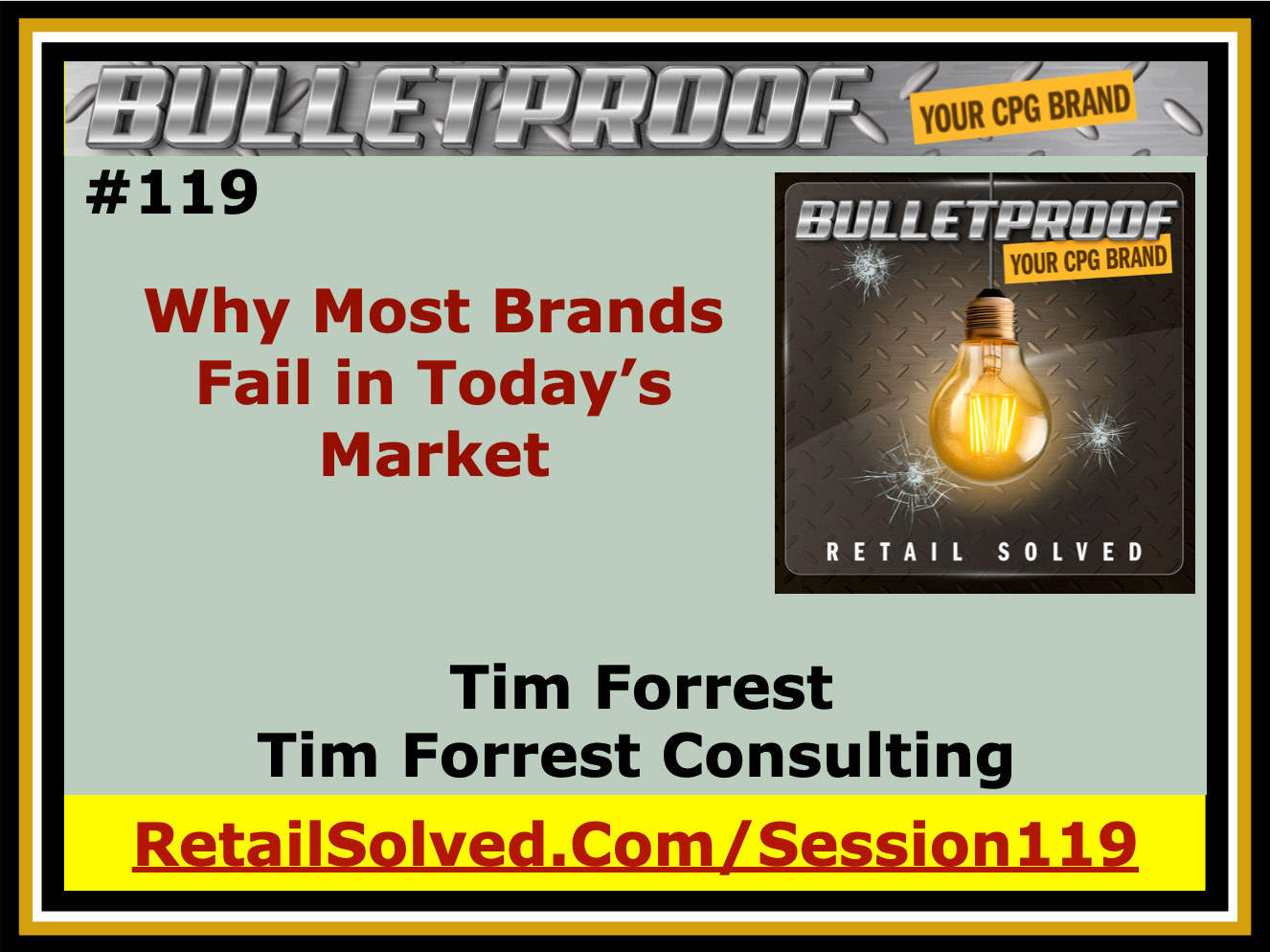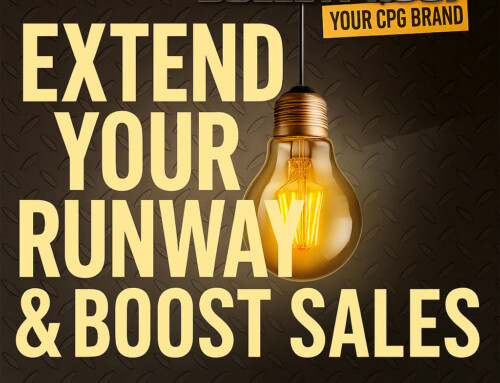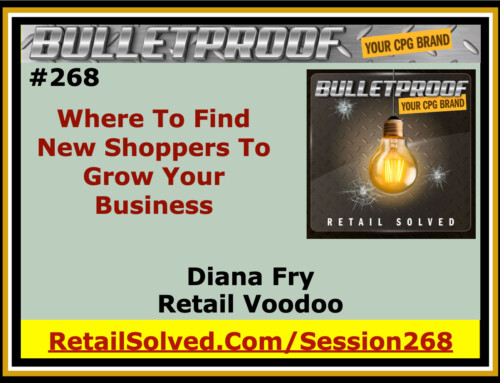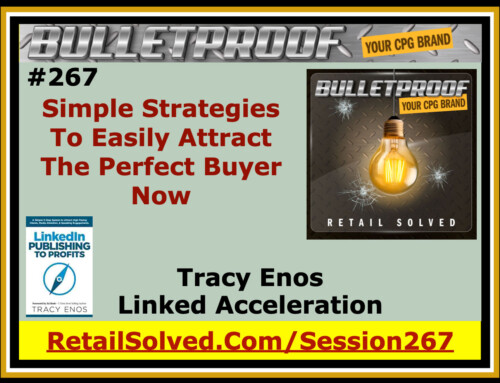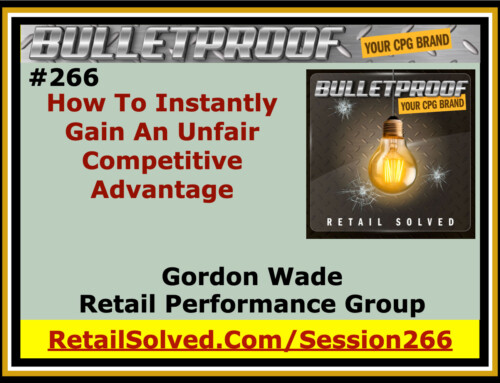Understand why most brands fail and discover key strategies to ensure your products are easily found and purchased. Retail execution, including proper merchandising and availability, is crucial for brand success. Retail audits are essential for brands to understand market conditions, competitor execution, and their own product performance. Most brands fail to do this – DON’T MAKE THIS CRITICAL MISTAKE!
Nothing is more important to the success of any brand than the customers who buy your products. They can’t buy your products if they cant find them. Having a solid selling strategy is not enough – you need to follow through to ensure sales success.
Click here to learn more about Tim Forrest Consulting
Listen where you get your podcast
Important: Brand Secrets and Strategies has been rebranded to Retail Solved. Please swap all BrandSecretsandStrategies.com URL’s with RetailSolved.com. This is now the Bulletproof Your Brand podcast. Thank you for listeni BRAND SECRETS AND STRATEGIES PODCAST #119 Hello and thank you for joining us today. This is the Brand Secrets and Strategies Podcast #119 Welcome to the Brand Secrets and Strategies podcast where the focus is on empowering brands and raising the bar. I’m your host Dan Lohman. This weekly show is dedicated to getting your brand on the shelf and keeping it there. Get ready to learn actionable insights and strategic solutions to grow your brand and save you valuable time and money. LETS ROLL UP OUR SLEEVES AND GET STARTED! Dan: Welcome. Have you ever played a sport, or watched a sport on TV, or even live or in person? One of the key elements of every single sport is that you've got to follow through. In other word, when you run up to the ball to kick it, you've got to follow through. When a golfer lines up for the perfect shot, they've got to follow through. The point is this: the follow through is the most important part of any swing, or any kick, or any throw. It's the follow through that helps guide the ball into the net, or into the cup, or down field to the waiting player, or across home plate. The same holds true in business. In fact, it's even more critically important in business, because this is where most brands fail. A lot of brands unfortunately believe that once a distributor picks up their product, or once a broker gets involved, then their job is finished. They can go back to making more product for the next time the distributor shows up, or whatever. Nothing could be further from the truth. And while, yes, some distributors do a phenomenal job of getting the product to the retailer, and some brokers do a great job of getting the product onto the shelf at the retailer's store, that's not always the case. This is something that you don't want to blindly entrust to anyone else. You need to keep checking on your brand on a regular basis to ensure that it's properly merchandised, and that the way that it looks on the store shelf, or on the display, accurately represents your brand; what you want your brand to stand for. So why does this matter, and why is it important to you? Remember that the most important thing is the way the consumer perceives your product on the shelf. You never get a second chance to disappoint a customer. From their standpoint, what is the commitment you, as a brand, has made to support them, to help them get the products that they want, wherever they shop? Sometimes, the product doesn't get rotated properly, or there are out of stocks, or not enough product gets ordered. On this podcast, I talk a lot about products being put in the wrong place when they get or gain distribution. Or a promoted product, whether it be a demo or just off the shelf, sells out, and then they've got nothing to sell, and the shelf is empty. This is where execution matters so much, and this why this episode, perhaps more than the other episodes, is so critically important. These are the simple things that every brand must do if they want to be around for a week, a month, a year, or even longer. I tell all the brands that I work with that the selling extends well beyond after the consumer takes it home and shares it with their friends and family. It continues as they evangelize about the product, and it continues as they put the product on their list for the next time they go shopping. The shopper's journey has changed, and shoppers today have almost virtually unlimited choices of where they spend their hard-earned money. It's critically important that you make sure that wherever your product is sold, that's it's available. And that you help that retailer, whether it be an online retailer, or a traditional retailer, remain relevant in the consumer's eyes. This is why it's critically important to make sure that everyone who touches your product is in lock step, and they have the same passion and authenticity and enthusiasm as the founder does. That anyone who touches your product has the same commitment to sales excellence; that it's rotated properly, that it appears on every single shelf where it belongs; that it's not misplaced, mislabeled, damaged in any way, shape, or form. That you can amply supply and support any promotion or any distribution you have. For example, getting into a store with a high volume, and you're not prepared for it. This is why it's so important for you to know your numbers. You need to know that if you sell your product at a 20 cent discount, or if you put it on a display, how much more product do you need? That's the topic of today's podcast: execution. This is your roadmap for sales success. This will determine how long your brand will be around; a week, a month, a year, or a decade, or even longer. Before I go any further, I want to remind you that there's a free downloadable guide for you at the end of every podcast episode. I always try to include at least one easy to download, quick to digest strategy that you can instantly adopt and make your own. One that you can use to grow sustainable sales, and compete more effectively. Remember, the goal here is to get your products on more retailers' shelves, and into the hands of more shoppers. I appreciate you listening. If you like the podcast, please share it with a friend, subscribe, and leave a review. Now here's my guest, Tim Forrest, of Tim Forrest Consulting. Tim, thank you for coming on today, for sharing your insights with us. I appreciate you coming on to help celebrate something exciting that we're gonna talk about in a minute. Can you begin by telling us a little bit about yourself, and your background, and how you got to where you're at today? Tim: Great, Dan. Thank you so much, I appreciate being on here today, and I'm looking forward to our topic, really talking about retail store audits, and some of the, really the key, probably the key, one of the most important things to solving problems for retail brands. A little bit about my background, which you asked about, thank you, I started, actually, loading trucks in this industry 31 years ago. So I'm loading food trucks 31 years ago, and I quickly moved off, I was actually driving a truck, so that means I was getting to deliver in the back door of every major food channel in America. That goes from retail to food service, leisure, theme parks, major league ball parks, and so I understand what was happening, what's happening in the market. From that, I went working, I was able to go to work for some of the largest brands in the world, with Nestle and Unilever. And so after 10 years of working with the biggest brands and learning really what to do, and following so many of their systems, their programs, and what their expectations were, including doing retail store audits, I had the opportunity to start my own consulting company 21 years ago. And that's what I've done. I've helped so many brands, so many entrepreneurs and emerging brands really deal with some of their most pressing problems, and understand ways to fix them. So often they're just basic processes, basic systems that I learned working for the biggest brands that they haven't been exposed to, and we just do it in a format, and with a style, and the budget that a food entrepreneur can handle. And we bring that to market; we found tremendous success, tremendous success. My clients, I'm not aware of many people who have had so many clients go from zero to more than a million dollars in sales. I've had products that I've launched that have gone on to do over $200 million dollars. Once we got it going and launched, other people took over, but I was excited to be really the person that brought that market, and get involved with. Really the why we're talking today and discussing this important topic- Dan: Sure, absolutely. And I appreciate you sharing that, and Tim, I've had the privilege of talking to you on several occasions, and we have a similar background in that I started as a DSD driver myself, and I worked my way up from delivering products in the back of stores up to being a national category captain for big brands. I also worked for Unilever, by the way. But the point is this: by learning how to do things, the basics, and learning and understanding exactly what's required, to be able to help a brand successfully grow, when you're ... Let me frame it this way. As a DSD driver, it's your responsibility to do all the merchandising, all the, you know, make sure the product is on the shelf properly, that it's rotated properly, everything. And what's unique about that position that's different than what most brands deal with is that this is what you're responsible for. If your product doesn't sell, or if it goes out of code or something like that, not only does it embarrass the retailer, but it comes right out of your commissions. And what I'm getting at is this: as a DSD driver, you earn a commission for every product you sell. And every product that spoils or gets damaged or whatever, that comes out of your paycheck. And so you learn very quickly how to do this right. And I'm framing it this way for this reason. Tim and I are together on this podcast as a followup to the last podcast we did, where we want to talk about or celebrate a new free mini course that we just launched called Why Most Brands Fail: The Road Map to Sales Success. The gist of it is this: shoppers can't buy your products if they can't find them. Flawless execution of your brand's strategy's critical to your survival. As Tim mentioned, he and I have worked with hundreds of brands, and one of the biggest challenges that literally every brand faces, even the big brands, is poor execution at retail. You've got to make sure that shoppers can find your product, and you've got to make sure that when your products ends up on the shelf, that you're putting your best foot forward every step of the way. So, Tim, thank you for sharing that. Let's start by talking a little bit about some of the basic problems that we've seen, and maybe some of the stories, some of the anecdotes we've seen, as we've worked with our clients. Can you share a couple? Tim: Yeah, let's just take three, real quick scenarios or situations. Intentional issues at retail by competitors. And so I've seen multiple situations where competitors, and it can be anyone in the competitive group, so it can be a sales rep, it can be a broker, it can be a store ... You just mentioned DSD, Door Store Delivery personnel, but they'll adjust the set, they'll remove tax, they'll do things to put themselves in a better position, and if you're not aware of it, even placed in the store, you know, that will actually put you in a negative position, and possibly be the reason you'll be discontinued in that store. The second piece of that is even less transparent or really able to be seen by people. You mentioned you were the category captain. There are ... If you're not aware of the set, the category in taking a lead on where your products are going to be housed and shelved within that particular category set, and each ... And also each type of store will have their own set, so if there's four sets, you know, four types of stores in a chain, they're gonna have four different sets, and often times they'll have many more than four different sets. So someone is leading the charge on developing the category, and the category schematics planagrams, and that you just mentioned category captain, so you've got to be aware of this. You've gotta know what's happening in the store. You've gotta know what's happening on shelf, and then you've gotta be leading the charge on where your product is gonna go on shelf. And so many folks are missing the beginning steps of fully understanding the opportunities at retail by not doing store audits, by not having command of the category, and not fully understanding their product and where it should be in the set. You know, the third point would be, you know, in the big third point, or third T in this area that I share so often is that you think you can delegate this to other parties, but this is the way you keep the system honest. This is the way you deliver and drive success through the system. Your broker needs someone to go behind them; the retailer needs someone to check on the sets to make sure they're right, and there's no one in the system other than you that can really care the charge and be responsible for the success at retail that you must be, that you must take ownership for your brand. Dan: Thank you for sharing that. And let me back up quite a bit. Things in natural today are the same as they were in mainstream when we started in this industry; in other words, we called on every single retailer, every single store. We had to make sure that the facings were right, that the merchandising was proper, et cetera. Same as things are in natural today. So just want to frame it that way. Now one of the benefits of working for a big CPG company back then is that they installed certain, like you said, systems and processes. This is the way, you just did it this way. In other words, you made sure that when you walked into the store, what was the first thing you did, the second thing, the third thing, et cetera. And you got in a habit, a really good habit of making sure that you were executing for every different product, making sure your tags were right, et cetera. So you mentioned the tags. Now, you don't see that as much with the big stores. Little bit, sometimes. But what Tim's getting at is if a tag falls off, if someone bumps into a retail display and knocks your, the price tag off for your product, and there's an out of stock there eventually, then the retailer doesn't always reorder it. So that's an issue. Or maybe the tag gets put in the wrong place, and now all of a sudden, instead of ending up being at eye level, you're on the bottom or something like that. And so it's imperative that you make sure that your product is merchandise well it belongs. And one of the things that we used to deal with a lot is that when we were starting out in this industry, is that our competitors would move our products around. It was kind of a game that we played. You don't see that a lot today, at least not in mainstream. But I do hear about it a lot in natural. The point is this: when you're working with a retailer, you need to understand exactly where your product goes. You need to understand where the tag goes, what are the retailer's expectations for your brand? And you need to help execute the retailer's, against the retailer's expectations as you're merchandising your product. Now, one of the things I really want to point out here, and this is something I learned early on, is that your brand has your name on it. Think of it this way. Your brand has your name on it. Think of it as a blank check. The retailer, or the consumer has the ability to decide how much you're gonna get paid. Whether or not your brand's gonna be successful, whatever. In other words, every thing that happens to your product, whether it's an out of stock, it's a mismerchandised, or anything else, damage, then that's a reflection, a poor reflection on your brand. And so from the consumer's perspective, it's not the broker's fault or the retailer's fault or anyone else's fault, it's the brand's fault. And you need to take ownership like that because that's how you ensure that your customer gets the very best from you at every point of your sales funnel. So as we're talking about this, some of the things that we see a lot of the brands that we're working with have challenges here, for example, are distribution, merchandising, inventory, promotion, competitor merchandising, stock rotation. Tim, can you talk briefly about those, and why those matter? And why people need to, why the brands need to be taking a leadership role in this, and not entrusting it to someone else? And by the way, I'm not saying or suggesting in any way that a broker or a retailer can't handle this. What i'm suggesting, as I think you are too, and correct me if I'm wrong, is that again, if this is your brand, you've got your name on the package, you need to take ownership for this, and you've got to ensure that your product is properly merchandised in every single location. Could you share some anecdotes about that? Tim: Sure, yeah, Dan. So many of my clients act the way that I acted when I first had to start filling out, doing store audits, and store retail checks. So many of my brands don't see the value in this, and it reminds me of me having to fill out the reports years and years ago, thinking I'm not being necessarily competitive, and I've gotta make my numbers, and this is something I need to ignore so I can go on and do more face to face selling, get more displays, do other things. But this is for the longterm help and success of your brand. And it's vital that this gets done, particularly if you have goals and you want to achieve a year from now or five years from now, and you still want to be in business. The activity that happens at the retail set has to be done, and so many of my clients early on, they don't realize how valuable the information that can be found at retail can be. Just like I didn't realize that in those early reports. And it wasn't until years later I realized my missteps on really skimping in providing information needed to really help management understand how to drive the brand and how to be more successful at retail. Have you noticed that at all, where a lot of folks don't recognize the value of doing retail, checking retail stores? Dan: Yes, absolutely. In fact, from what I see, from the brands that I work with, really none of the brands understand this. This is something that is not taught in any business school. It's not taught in any seminar or any place else. This is something that we learn because we learned how to do it the right way originally. But a lot of brands overlook it. They think that once the product leaves the back door of their warehouse that they're finished. Wrong! That's where the selling starts. Tim: Yeah. And this is not something you can purchase from Nielsen. This is not something that can be bought from a SPINS report. This has to be done at retail. And so you're not gonna to be able to analyze accurate market conditions, you're not gonna be able to really get the information. You're not gonna really understand the problems that are happening at retail. You're not gonna be able to understand how your competitors are executing at retail, and how your own product is being executed at retail. And your brokers are so busy ... Here's the other key. Here's the other key. Your brokers are so busy dealing with the brands that are doing retail audits that they're not working your product as much as they should be working it if you were doing the retail audits. And so a lot of folks think they want to get more value from their broker, and this is one absolute way that you do it, and this is how some of the most successful brands dominate and take control of their broker relationship, is because someone in their company is doing store audits, and is aware of what's happening at retail. Dan: I'm glad you made the point about not being able to have line of sight to what's going on on shelf. Let me give everyone an example. And this is something that a lot of brands face, even big brands. Let me repeat that. Even big brands. Syndicated data only tells you what happened. It doesn't tell you what's going on on the shelf. It doesn't tell you that you had an out of stock for three days in a row. And what's frustrating is that a lot of people when they look at the data, they say, look, my sales are doing great. And so let's say that if I've got 12 items on the shelf, and it says that in that particular store, I sold 12 items that week, a lot of brands might be saying, wow! That's great. Aren't I doing wonderful? But the reality is, you may have been out of stock three or four days out of that week. And the point is this. There's no way to identify that problem with looking at syndicated data. Now that's not a failure of the syndicated data. The point I'm trying to make is that if you're not keenly aware of what's going on at retail, and not checking the stores, and not paying attention to what's going on at retail, this is one of the things you can miss. And when you've got out of stocks, again, not only does it embarrass the retailer, it makes it very difficult for them to say yes to your next product introduction, and on top of that, you're upsetting their customers. You're allowing their customers to leave the store empty handed. So it's a tremendous failure on your part, again, because you the brand need to be aware of this. So the benefit, like you said, Tim, and I appreciate your sharing this, of being able to do store audits, is that these are some of the basic things that you need to be looking at. Now, one of the other things, you know, we talked about not blindly entrusting this to your broker, to your retailer, or anyone else. You know, when we started in this industry, and I talk about this a lot, we had dedicated people, when I was working for Kimberly Clark and Unilever, that went into every store and merchandised every one of our products. We attended the same sales training. We got the same bonus structure. In other words, we were lockstep, making sure that we were executing at shelf as a team, as a unit. However, when we went to a broker model, an indirect model, what happened is the broker instead of being responsible for our items, and getting a bonus if our items sell, et cetera, they had now instead of 40 items, maybe 200 items. They had the same hour and a half, or two hours or whatever, to look at the products. My point is this. There's no way they can make sure that every single product is merchandised correctly. That's one of the most important reasons why you as a brand need to be walking the stores every single opportunity. And every single market your product is selling at. Tim, do you have other anecdotes or stories about that? Tim: Yeah, Dan. I wanted to share that we're not suggesting that if you sell to 100 store chains that you're gonna visit a 100 stores. Dan: Well said. Tim: What I like to do, and the way I've done it, you can share your style, but generally I like to do handful of stores. So three to five stores of a smaller chain. If it's larger, I need to do at least eight stores, and if everything looks good in those eight stores, I feel confident, and you know I'm good to go if everything else is looking good. But in each market per store, I want to visit at least eight stores per market. And then also, I try to understand the nuances of distribution. So if I have three different distributors, I want to hit several stores with each distributor. So I don't want to do all eight stores with one distributor, knowing that say I have a different distributor on the north side of town, or a different distributor in an adjoining state, and think that that's enough store checks, because you really, you have to understand your full distribution. And so you've gotta get a few stores from everywhere in your business of what's actually happening at retail. And so I'm not sure, maybe you might check up more stores than I do, I don't know, but I need to have a strong understanding of the stores. Also, I want to go to different stores over time, unless there's an issue. If there is an issue, you have to double back and make sure in your notes that you're gonna come back to that store and verify the problem's been fixed, because it's not just you send an email that store's gonna be fixed, you're gonna send information, and then you gotta verify and check up on it. And it's important that occurs. Dan: Well said, and so when I was working for Unilever and Kimberly Clark for the most part, I practically lived on an airplane. Now I was in category management, so I wasn't responsible directly for merchandising the product or seeing how the products were merchandised. But every time I flew into a city, I always made a point to go into at least a couple different stores. And to your point, I would go to different stores or different chains, or whatever, to take a look at how the stores were merchandised. Again, this was not my core responsibility. I was in category management. While category management is sometimes a function of sales, my job was to be working with the headquarters, or dealing with the buyers, et cetera. But yet, I would walk into the stores, and I would take a look at the products. One, this is what you do when you're part of a team. So I was able to take an assessment or take a look at what other products, how our products were performing on different shelves, et cetera. The other thing is, I got a flavor for the retail. Now, remember, I'm in the process of meeting with the retailer while I'm in town, and so give me some insights as to how their stores are merchandised, and it gave me an opportunity to learn more about the retailer. Become an expert in the retailer. And the other benefit of this is that I was able to look at other categories. And so, I might see something in the pet food category, for example, that I really liked, and I thought was really impressed with, and I could figure out a way, a creative way, to apply that to the diaper category, the facial tissue category, or whatever. My point is this: don't live in a bubble. Don't believe that your category's unique and different from anything else in the store. You might see a retailer in one market that might have a really cool, creative way to merchandise products in their store. And if you take those strategies back to a different retailer and a different market, well then you're a hero. And they're going to appreciate you, because you're helping them compete more effectively; you're helping them drive sales by leveraging your product. So there are a lot of other benefits to being able to do this, and to being able to do it well. And then we were talking a little bit about the broker. You know, again, I mentioned that the brokers weren't incented by the big companies I was working for. But yet when I could go in and work with our broker partner and be able to help them understand more about our product, how it should be merchandised, and help guide them to be successful with our product, then that helped us out as well. Tim, your thoughts? Tim: Yes, Dan, I wanted to share that folks listening to this that own food brands, and so founders and presidents, this is a big issue in my area, 'cause they think or they're concerned that they're not supposed, necessarily, that's not their turf, that's not their area. That they have a sales manager or VP of sales, or they have a sales team, and they don't want to necessarily step, a lot of times the founders of the food brands, they might be bakers or they're makers or they're creators of these awesome food products, and then they grow the business beyond where they started, and branch out in retail, and so they bring on talent, and they just sort of, they just basically delegate this whole role of sales and retail to the team. And so if they don't have brokers, and they do have a sales, a dedicated sales force, it's the responsibility of the president to make some of these stops that we're talking about, visit some of these retail stores, to be able to execute and perform the exact same functions that we're discussing as far as an oversight, and being responsible for the success, and so just because you're the president or running the brand, you need to be out there, and I've seen several, not many or not all of them, but I've seen multiple cases where they kind of expect the sales leader to take care of this and handle this, and they're not actually doing any retail audits. Dan: Absolutely. And this is so critically. Important. I mean, you think about it. We're talking about execution. Retail execution. This is why most brands fail. If you think about a football team or a hockey team or a soccer team or whatever, if they don't execute properly, they're not gonna win. If you think about an automobile manufacturer, if they don't put the products, the parts on the car correctly, then their cars aren't gonna be sold. In other words, quality's important. And this is true of every aspect of anything that we do. If you don't execute properly in show, you don't show up on time, and you're not prepared to take your test, and you didn't study, you're gonna fail. My point is this: this is just the basic stuff, and this isn't really hard. These are the basics, this is not rocket scientist. But yet, these are so critically important. The problem is is that so many of the young brands that we work with overlook this. Or they expect that, or that they trust, blindly trust, that someone else is taking care of this for them, when in reality, again, if your name's on the package, that's your brand, that's your baby, you're responsible for it. And you really need to adopt that mindset if you're going to be successful. Tim: If you're a baker, you're a maker, and you're in the plant, and that's really your role, where you want to be as a founder of the business that's okay, but just know that you've got to verify that this has happened. It's your brand, it's your company, and it's your responsibility to know that this is occurring within your organization, and so someone has to be doing this. To have a, I think to really care for and administer for your brand so that you're successful. Dan: Absolutely. And so I mentioned earlier that the reason we're doing this today, the reason we're talking about this is because we launched a free course. This is our way of giving back. This is our way of helping you succeed. Because if you succeed, then we all succeed. So the mini course, the free mini course, is Why Most Brands Fail: The Road Map to Sales Success. Shoppers can't buy your products if they can't find them. Flawless execution of your brand strategy is critical to your survival. Time, is there anything we missed that you want to- Tim: No, I'm just excited about the course because we spent a lot of time, and we share in there the handouts, so we're gonna go in there and really dive into what is the purpose of retail audits, and how it's a value to brands. And then not only are we gonna talk about the purpose, I mean we actually give real world, I mean this is as basic it can be, we provide an actual worksheet, and so we explain what we're looking for, what is there at retail that should be inspected, and then you actually put together, you've got a great sport card that we actually can be used at retail as well. So we've got three, in addition to the actual course, where we'll be teaching, we have those three handouts, PDFs that they can download as far as, you know, why even do all this? What is it we're gonna? Why do we need to do store audits? And then actually how do you do store audits? And then actually the tools that you develop, which is awesome, the audit worksheet, so they can actually use that, or they can assign that to someone else, and allow them to use it in order to capture this data. Dan: Thank you for saying that. And that's why we're partnering on this. Because I was so thoroughly impressed with what you bring to the table, with what you've been doing with your client. The way we put this course together is this: we wanted to give you quick win. We wanted to be able to give you something that you could instantly take, and bake into your own brand's DNA. Something that you could use to build a healthy foundation. You can get there by going to brandsecretsandstrategies.com/salessuccess. In the mini course, the things that we're gonna cover are, you're gonna learn how to make it easy for shoppers to purchase your products, improve the customer journey, and remove unnecessary friction from the buying process. Remember, customers want convenience. They want to be able to find your product wherever they shop. Turn your merchandising strategy into a growth engine. Ensure that shoppers can easily find your products where they shop. Avoid the mini pitfalls that derail and even bankrupt brands. We've talked about this a lot. In fact, in podcast episode 104, I shared a true story about a brand that was merchandised in the wrong place, and something as insignificant as that could derail a brand and possibly even bankrupt them. It's something that could cost a brand a lot of money to fix. How to take a proactive role and to help your retail partners grow category sales with your brand. Gain a significant and sustainable competitive advantage, effectively communicate your brand strategy through proper merchandising, product placement, pricing, and promotions. Execute your brand strategy flawlessly in every store consistently using the retail audit checklist. This is so critically important. You've gotta make sure that when a consumer walks into your store, when a shopper walks into a store, that they can find your product easily, and that it's gonna be in the same place, and that they can expect it to be merchandised properly in every store. How to maximize each and every selling opportunity. And how to leverage your merchandising strategy to enhance your selling story. Time, is there anything that you'd like to add? Tim: No, I think we covered it all. I just think if people feel like they gained anything from our discussion today, what they'll get from the actual course will be 10 fold. And I would really, I suggest they sign up immediately and go for it. Also, if anyone got, there was any value in this course, anyone that's listening, if you got value from our podcast today, I'd ask that they pay it forward by sharing this with one friend, just one person they think in the food business that this would provide value. And share that with folks, kind of to pay it forward for us putting this together. Dan: Thank you, I appreciate you saying that. Cannot agree with you enough. Again, we're doing this because we want to give back. This is how we give back. We want to help you be successful. We want to help ensure that you can get your products on more store shelves and into the hands of more shoppers. Thank you Tim, for sharing that. You can get a link to the course as well as this week's free download at the essential new item checklist, the recipe for success, where we talk about the foundation that every brand needs to have every time you present a new item to a retailer. You can get there by going to brandsecretsandstrategies.com/session119. Tim, thank you for partnering with me on this mini course, and thank you for coming on today. And for everyone else, thank you for listening, and I look forward to seeing you in the next episode. Tim: Thank you, Dan. This episode's FREE downloadable guide The great equalizer between small and large brands. Learn how it has evolved and the advanced strategies that retailers really want and need from you and your brand. CLICK HERE TO DOWNLOAD YOUR FREE STRATEGIC GUIDE: What is Category Management and Why It's So Important Thanks again for joining us today. Make sure to stop over at brandsecretsandstrategies.com for the show notes along with more great brand building articles and resources. Check out my free course Turnkey Sales Story Strategies, your roadmap to success. You can find that on my website or at TurnkeySalesStoryStrategies.com/growsales. Please subscribe to the podcast, leave a review, and recommend it to your friends and colleagues. Sign up today on my website so you don’t miss out on actionable insights and strategic solutions to grow your brand and save you valuable time and money. I appreciate all the positive feedback. Keep your suggestions coming. Until next time, this is Dan Lohman with Brand Secrets and Strategies where the focus is on empowering brands and raising the bar.
Enter your name and email address below and I'll send you periodic brand building advice, tips and strategies.
Sign up to receive email updates
FREE Trade Promotion ROI Calculator:
Click Here To Maximize Sales And Profits
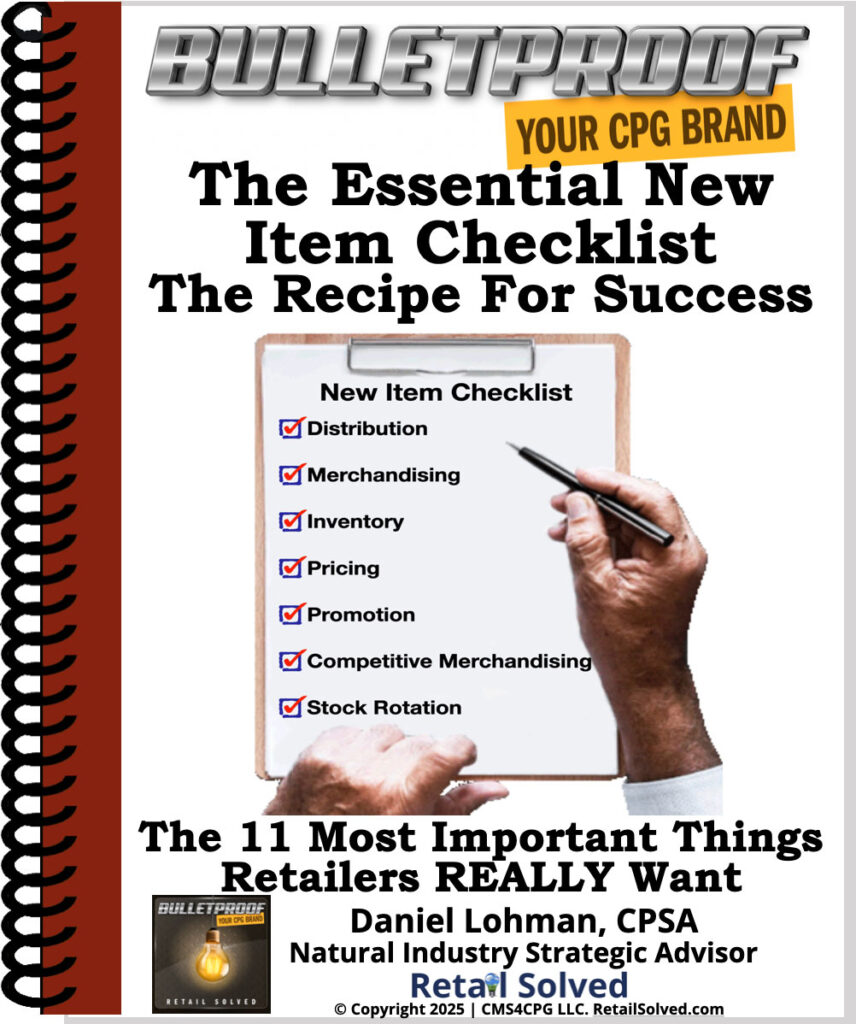
The Essential New Item Checklist – The Recipe For Success
Want A Competitive Edge? The Recipe For Success
New product innovation is the lifeblood of every brand. New products fuel sustainable growth, attract new shoppers and increase brand awareness. Learn the critical steps to get your product on more retailer’s shelves and into the hands of more shoppers. Maximizing your trade marketing can pour rocket fuel on your launch.
Image is the property of CMS4CPG LLC, distribution or reproduction is expressively prohibited.
